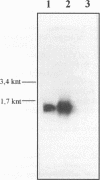Abstract
The thrC gene of Brevibacterium lactofermentum was cloned by complementation of Escherichia coli thrC auxotrophs. The gene was located by deletion mapping and complementation analysis in a 2.9-kb Sau3AI-HindIII fragment of the genome. This fragment also complemented a B. lactofermentum UL1035 threonine auxotroph that was deficient in threonine synthase. A 1,892-bp DNA fragment of this region was sequenced; this fragment contained a 1,446-bp open reading frame that encoded a 481-amino-acid protein having a deduced M(r) of 52,807. The gene was expressed in E. coli, by using the phage T7 system, as a 53-kDa protein. The promoter region subcloned in promoter-probe plasmids was functional in E. coli. A Northern analysis revealed that the gene was expressed as a monocistronic 1,400-nucleotide transcript. The transcription start point of the thrC gene was located by S1 mapping 6 bp upstream from the translation initiation codon, which indicated that this promoter was one of the leaderless transcription-initiating sequences. The threonine synthase overexpressed in B. lactofermentum UL1035 was purified almost to homogeneity. The active form corresponded to a monomeric 52.8-kDa protein, as shown by sodium dodecyl sulfate-polyacrylamide gel electrophoresis. The purified enzyme required pyridoxal phosphate as its only cofactor to convert homoserine phosphate into threonine.
Full text
PDF

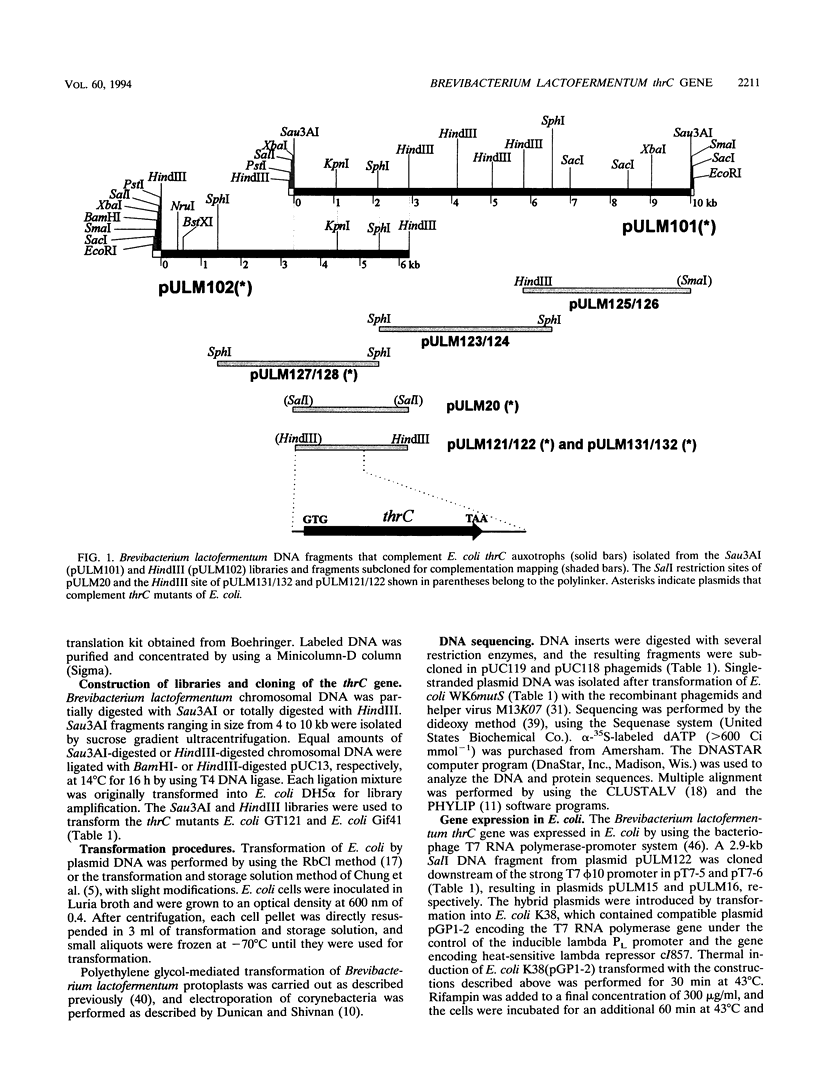


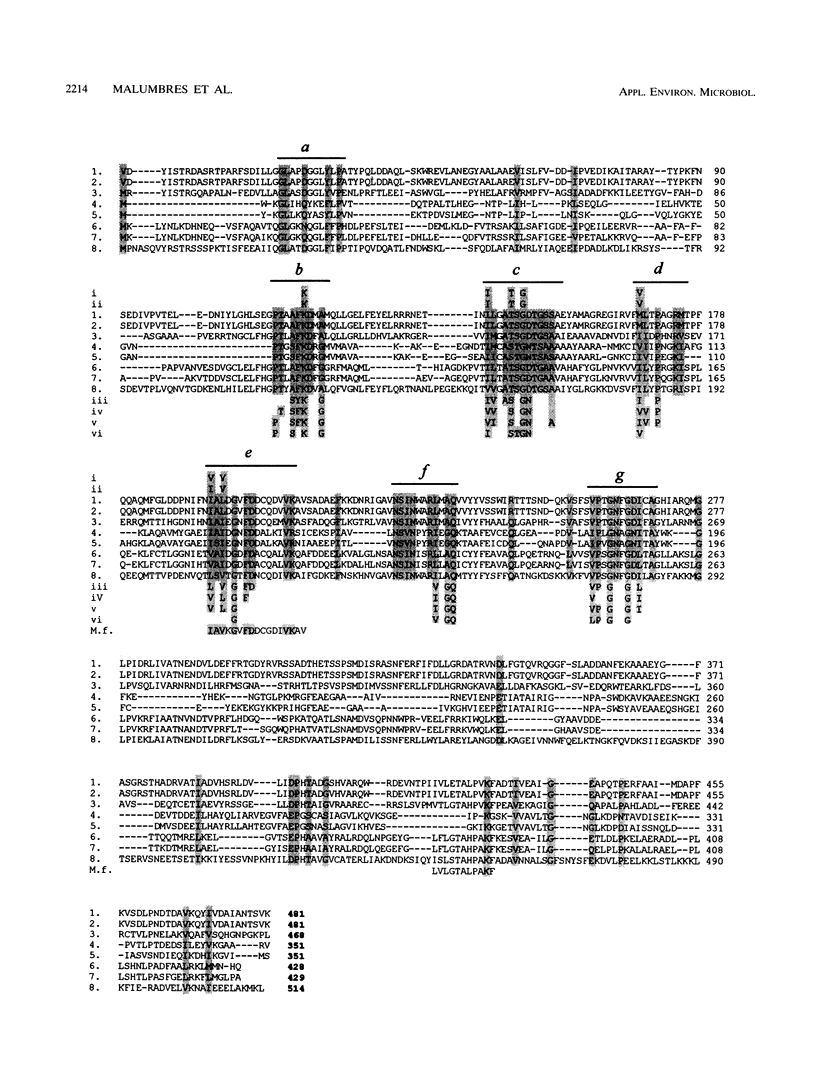

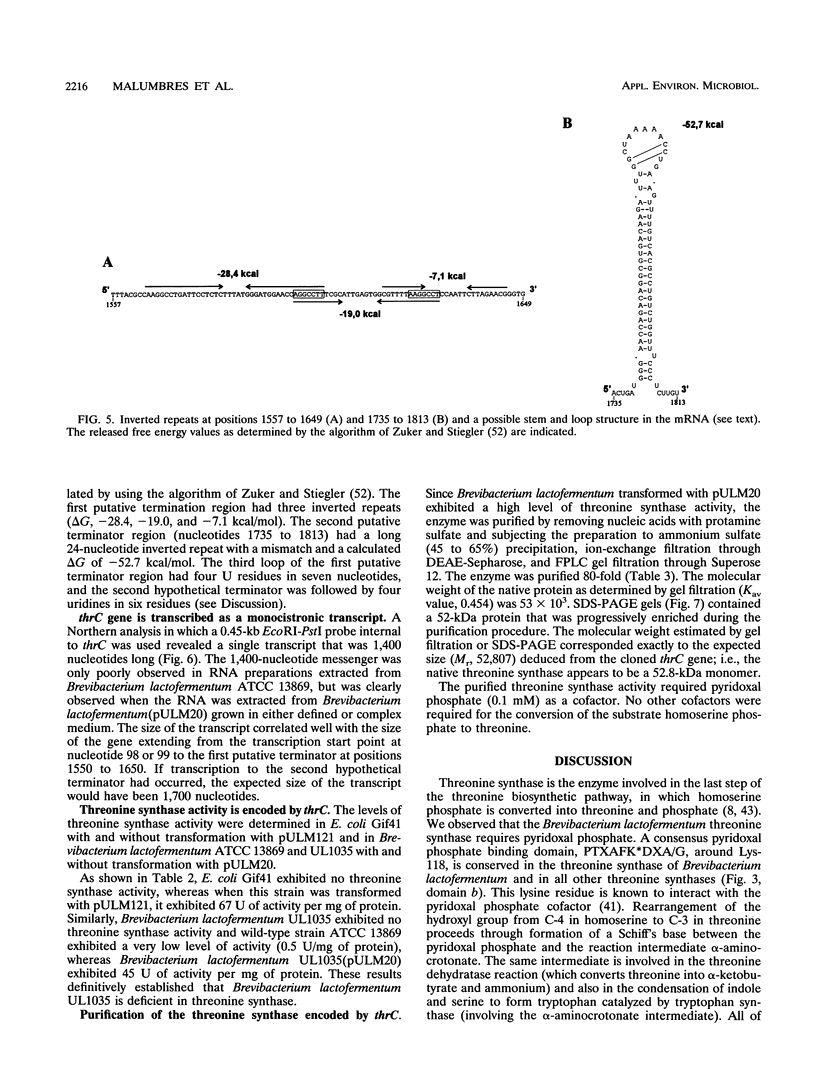
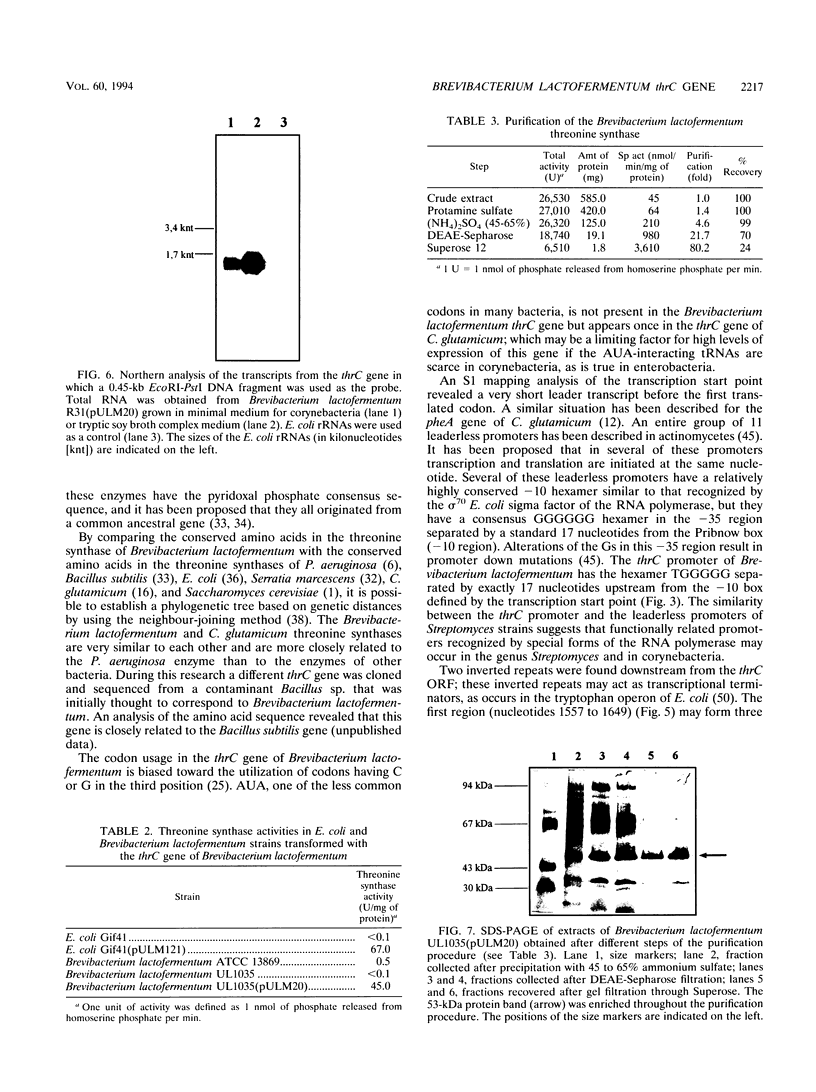
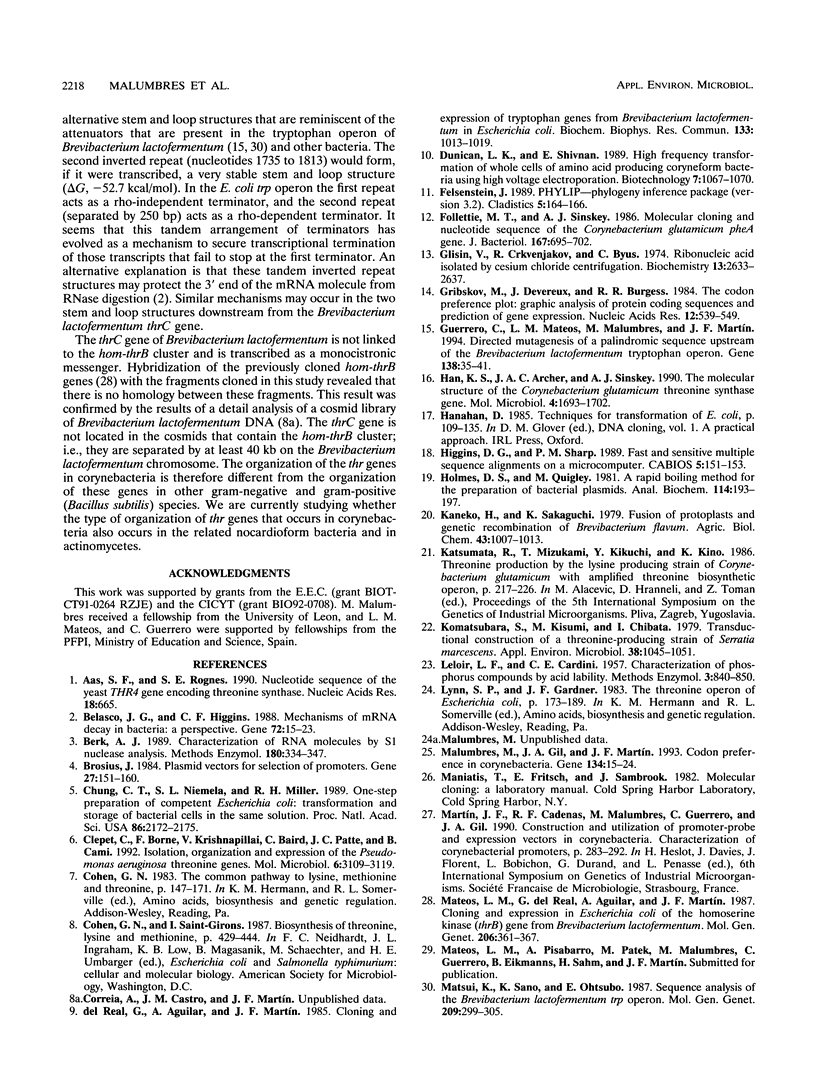

Images in this article
Selected References
These references are in PubMed. This may not be the complete list of references from this article.
- Aas S. F., Rognes S. E. Nucleotide sequence of the yeast THR4 gene encoding threonine synthase. Nucleic Acids Res. 1990 Feb 11;18(3):665–665. doi: 10.1093/nar/18.3.665. [DOI] [PMC free article] [PubMed] [Google Scholar]
- Belasco J. G., Higgins C. F. Mechanisms of mRNA decay in bacteria: a perspective. Gene. 1988 Dec 10;72(1-2):15–23. doi: 10.1016/0378-1119(88)90123-0. [DOI] [PubMed] [Google Scholar]
- Berk A. J. Characterization of RNA molecules by S1 nuclease analysis. Methods Enzymol. 1989;180:334–347. doi: 10.1016/0076-6879(89)80110-7. [DOI] [PubMed] [Google Scholar]
- Brosius J. Plasmid vectors for the selection of promoters. Gene. 1984 Feb;27(2):151–160. doi: 10.1016/0378-1119(84)90136-7. [DOI] [PubMed] [Google Scholar]
- Chung C. T., Niemela S. L., Miller R. H. One-step preparation of competent Escherichia coli: transformation and storage of bacterial cells in the same solution. Proc Natl Acad Sci U S A. 1989 Apr;86(7):2172–2175. doi: 10.1073/pnas.86.7.2172. [DOI] [PMC free article] [PubMed] [Google Scholar]
- Clepet C., Borne F., Krishnapillai V., Baird C., Patte J. C., Cami B. Isolation, organization and expression of the Pseudomonas aeruginosa threonine genes. Mol Microbiol. 1992 Nov;6(21):3109–3119. doi: 10.1111/j.1365-2958.1992.tb01768.x. [DOI] [PubMed] [Google Scholar]
- Follettie M. T., Sinskey A. J. Molecular cloning and nucleotide sequence of the Corynebacterium glutamicum pheA gene. J Bacteriol. 1986 Aug;167(2):695–702. doi: 10.1128/jb.167.2.695-702.1986. [DOI] [PMC free article] [PubMed] [Google Scholar]
- Glisin V., Crkvenjakov R., Byus C. Ribonucleic acid isolated by cesium chloride centrifugation. Biochemistry. 1974 Jun 4;13(12):2633–2637. doi: 10.1021/bi00709a025. [DOI] [PubMed] [Google Scholar]
- Gribskov M., Devereux J., Burgess R. R. The codon preference plot: graphic analysis of protein coding sequences and prediction of gene expression. Nucleic Acids Res. 1984 Jan 11;12(1 Pt 2):539–549. doi: 10.1093/nar/12.1part2.539. [DOI] [PMC free article] [PubMed] [Google Scholar]
- Guerrero C., Mateos L. M., Malumbres M., Martín J. F. Directed mutagenesis of a regulatory palindromic sequence upstream from the Brevibacterium lactofermentum tryptophan operon. Gene. 1994 Jan 28;138(1-2):35–41. doi: 10.1016/0378-1119(94)90780-3. [DOI] [PubMed] [Google Scholar]
- Han K. S., Archer J. A., Sinskey A. J. The molecular structure of the Corynebacterium glutamicum threonine synthase gene. Mol Microbiol. 1990 Oct;4(10):1693–1702. doi: 10.1111/j.1365-2958.1990.tb00546.x. [DOI] [PubMed] [Google Scholar]
- Higgins D. G., Sharp P. M. Fast and sensitive multiple sequence alignments on a microcomputer. Comput Appl Biosci. 1989 Apr;5(2):151–153. doi: 10.1093/bioinformatics/5.2.151. [DOI] [PubMed] [Google Scholar]
- Holmes D. S., Quigley M. A rapid boiling method for the preparation of bacterial plasmids. Anal Biochem. 1981 Jun;114(1):193–197. doi: 10.1016/0003-2697(81)90473-5. [DOI] [PubMed] [Google Scholar]
- Komatsubara S., Kisumi M., Chibata I. Transductional construction of a threonine-producing strain of Serratia marcescens. Appl Environ Microbiol. 1979 Dec;38(6):1045–1051. doi: 10.1128/aem.38.6.1045-1051.1979. [DOI] [PMC free article] [PubMed] [Google Scholar]
- Malumbres M., Gil J. A., Martín J. F. Codon preference in corynebacteria. Gene. 1993 Nov 30;134(1):15–24. doi: 10.1016/0378-1119(93)90169-4. [DOI] [PubMed] [Google Scholar]
- Mateos L. M., del Real G., Aguilar A., Martín J. F. Cloning and expression in Escherichia coli of the homoserine kinase (thrB) gene from Brevibacterium lactofermentum. Mol Gen Genet. 1987 Mar;206(3):361–367. doi: 10.1007/BF00428872. [DOI] [PubMed] [Google Scholar]
- Matsui K., Sano K., Ohtsubo E. Sequence analysis of the Brevibacterium lactofermentum trp operon. Mol Gen Genet. 1987 Sep;209(2):299–305. doi: 10.1007/BF00329657. [DOI] [PubMed] [Google Scholar]
- Mead D. A., Kemper B. Chimeric single-stranded DNA phage-plasmid cloning vectors. Biotechnology. 1988;10:85–102. doi: 10.1016/b978-0-409-90042-2.50010-6. [DOI] [PubMed] [Google Scholar]
- Omori K., Imai Y., Suzuki S., Komatsubara S. Nucleotide sequence of the Serratia marcescens threonine operon and analysis of the threonine operon mutations which alter feedback inhibition of both aspartokinase I and homoserine dehydrogenase I. J Bacteriol. 1993 Feb;175(3):785–794. doi: 10.1128/jb.175.3.785-794.1993. [DOI] [PMC free article] [PubMed] [Google Scholar]
- Parsot C. A common origin for enzymes involved in the terminal step of the threonine and tryptophan biosynthetic pathways. Proc Natl Acad Sci U S A. 1987 Aug;84(15):5207–5210. doi: 10.1073/pnas.84.15.5207. [DOI] [PMC free article] [PubMed] [Google Scholar]
- Parsot C., Cohen G. N. Cloning and nucleotide sequence of the Bacillus subtilis hom gene coding for homoserine dehydrogenase. Structural and evolutionary relationships with Escherichia coli aspartokinases-homoserine dehydrogenases I and II. J Biol Chem. 1988 Oct 15;263(29):14654–14660. [PubMed] [Google Scholar]
- Parsot C., Cossart P., Saint-Girons I., Cohen G. N. Nucleotide sequence of thrC and of the transcription termination region of the threonine operon in Escherichia coli K12. Nucleic Acids Res. 1983 Nov 11;11(21):7331–7345. doi: 10.1093/nar/11.21.7331. [DOI] [PMC free article] [PubMed] [Google Scholar]
- Parsot C. Evolution of biosynthetic pathways: a common ancestor for threonine synthase, threonine dehydratase and D-serine dehydratase. EMBO J. 1986 Nov;5(11):3013–3019. doi: 10.1002/j.1460-2075.1986.tb04600.x. [DOI] [PMC free article] [PubMed] [Google Scholar]
- Peoples O. P., Liebl W., Bodis M., Maeng P. J., Follettie M. T., Archer J. A., Sinskey A. J. Nucleotide sequence and fine structural analysis of the Corynebacterium glutamicum hom-thrB operon. Mol Microbiol. 1988 Jan;2(1):63–72. doi: 10.1111/j.1365-2958.1988.tb00007.x. [DOI] [PubMed] [Google Scholar]
- Saitou N., Nei M. The neighbor-joining method: a new method for reconstructing phylogenetic trees. Mol Biol Evol. 1987 Jul;4(4):406–425. doi: 10.1093/oxfordjournals.molbev.a040454. [DOI] [PubMed] [Google Scholar]
- Sanger F., Nicklen S., Coulson A. R. DNA sequencing with chain-terminating inhibitors. Proc Natl Acad Sci U S A. 1977 Dec;74(12):5463–5467. doi: 10.1073/pnas.74.12.5463. [DOI] [PMC free article] [PubMed] [Google Scholar]
- Santamaria R. I., Gil J. A., Martin J. F. High-frequency transformation of Brevibacterium lactofermentum protoplasts by plasmid DNA. J Bacteriol. 1985 Apr;162(1):463–467. doi: 10.1128/jb.162.1.463-467.1985. [DOI] [PMC free article] [PubMed] [Google Scholar]
- Schiltz E., Schmitt W. Sequence of Escherichia coli D-serine dehydratase. Location of the pyridoxal-phosphate binding site. FEBS Lett. 1981 Nov 2;134(1):57–62. doi: 10.1016/0014-5793(81)80550-9. [DOI] [PubMed] [Google Scholar]
- Shames S. L., Ash D. E., Wedler F. C., Villafranca J. J. Interaction of aspartate and aspartate-derived antimetabolites with the enzymes of the threonine biosynthetic pathway of Escherichia coli. J Biol Chem. 1984 Dec 25;259(24):15331–15339. [PubMed] [Google Scholar]
- Skarstedt M. T., Greer S. B. Threonine synthetase of Bacillus subtilis. The nature of an associated dehydratase activity. J Biol Chem. 1973 Feb 10;248(3):1032–1044. [PubMed] [Google Scholar]
- Southern E. M. Detection of specific sequences among DNA fragments separated by gel electrophoresis. J Mol Biol. 1975 Nov 5;98(3):503–517. doi: 10.1016/s0022-2836(75)80083-0. [DOI] [PubMed] [Google Scholar]
- Strohl W. R. Compilation and analysis of DNA sequences associated with apparent streptomycete promoters. Nucleic Acids Res. 1992 Mar 11;20(5):961–974. doi: 10.1093/nar/20.5.961. [DOI] [PMC free article] [PubMed] [Google Scholar]
- Tabor S., Richardson C. C. A bacteriophage T7 RNA polymerase/promoter system for controlled exclusive expression of specific genes. Proc Natl Acad Sci U S A. 1985 Feb;82(4):1074–1078. doi: 10.1073/pnas.82.4.1074. [DOI] [PMC free article] [PubMed] [Google Scholar]
- Thèze J., Saint-Girons I. Threonine locus of Escherichia coli K-12: genetic structure and evidence for an operon. J Bacteriol. 1974 Jun;118(3):990–998. doi: 10.1128/jb.118.3.990-998.1974. [DOI] [PMC free article] [PubMed] [Google Scholar]
- VOGEL H. J., BONNER D. M. Acetylornithinase of Escherichia coli: partial purification and some properties. J Biol Chem. 1956 Jan;218(1):97–106. [PubMed] [Google Scholar]
- Wu A. M., Christie G. E., Platt T. Tandem termination sites in the tryptophan operon of Escherichia coli. Proc Natl Acad Sci U S A. 1981 May;78(5):2913–2917. doi: 10.1073/pnas.78.5.2913. [DOI] [PMC free article] [PubMed] [Google Scholar]
- Yanisch-Perron C., Vieira J., Messing J. Improved M13 phage cloning vectors and host strains: nucleotide sequences of the M13mp18 and pUC19 vectors. Gene. 1985;33(1):103–119. doi: 10.1016/0378-1119(85)90120-9. [DOI] [PubMed] [Google Scholar]
- Zuker M., Stiegler P. Optimal computer folding of large RNA sequences using thermodynamics and auxiliary information. Nucleic Acids Res. 1981 Jan 10;9(1):133–148. doi: 10.1093/nar/9.1.133. [DOI] [PMC free article] [PubMed] [Google Scholar]
- del Real G., Aguilar A., Martín J. F. Cloning and expression of tryptophan genes from Brevibacterium lactofermentum in Escherichia coli. Biochem Biophys Res Commun. 1985 Dec 31;133(3):1013–1019. doi: 10.1016/0006-291x(85)91237-9. [DOI] [PubMed] [Google Scholar]





